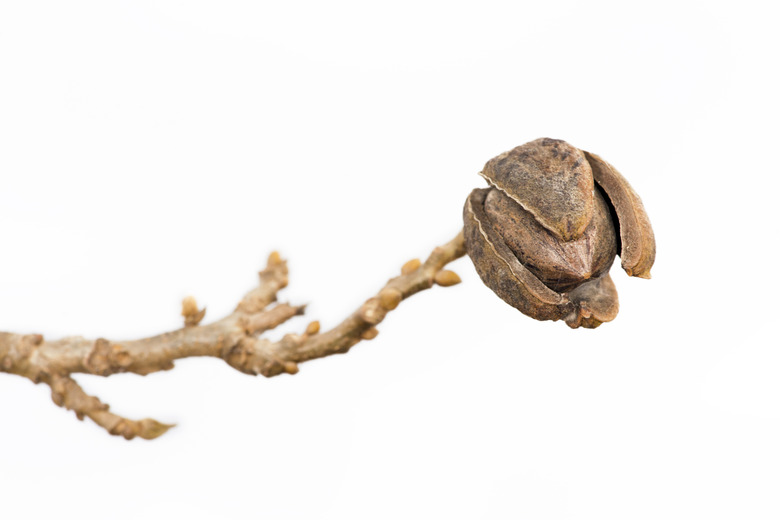Identification Of Hickory Trees
Hickory trees (Carya spp.) are prized commercially for their very tough, hardwood, but many species produce edible fruit and can be cultivated as specimen trees. Grow them in a site with rich, well-drained soil and full-sun exposure. About one dozen hickory species are native to the United States.
Hickory trees (Carya spp.) are prized commercially for their very tough, hardwood, but many species produce edible fruit and can be cultivated as specimen trees. Grow them in a site with rich, well-drained soil and full-sun exposure. About one dozen hickory species are native to the United States. Of those, four are most well-known. Telling them apart from each other can be tricky. If you look closely, however, you will be able to identify a few key differences among them.
- Hickory trees (Carya spp.)
- are prized commercially for their very tough, hardwood, but many species produce edible fruit and can be cultivated as specimen trees.
Hardy Pecan
The hardy pecan tree (Carya illinoinensis) is a hickory known for its fruit — the pecan nut. Hardy in U.S. Department of Agriculture plant hardiness zones 5 through 9, this tree can be identified by its sheer size sometimes; in the wild, it can tower to a maximum height of 100 feet and have a rounded canopy spread of 70 feet. Its bark is brown and scaly. In spring, male hardy pecans bloom with 4-inch-long, yellowish-green catkins. The female trees feature yellow, spiky flowers. Hardy pecan leaves are compound, with alternating leaflets ranging from nine to 17 on each leaf. Each leaflet ends in a point and ranges from 2 to 7 inches long. The pecan nuts average about 1 1/2 inch in length and are brown with thin shells and rounded bases tapering to a point. The nuts hang in clusters of three to six nuts.
- The hardy pecan tree (Carya illinoinensis) is a hickory known for its fruit — the pecan nut.
- The pecan nuts average about 1 1/2 inch in length and are brown with thin shells and rounded bases tapering to a point.
Shagbark Hickory
The shagbark hickory (Carya ovata), as its common name implies, is best known for its exfoliating bark. The grayish-brown bark of a mature tree peels from the trunk in long, slender strips. Hardy in USDA zones 4 through 8, the shagbark hickory reaches a maximum height and spread of 90 and 70 feet, respectively. It has an irregular, oval-shaped crown. The tree's sweet, dark-brown nuts are edible, somewhat flattened and split open when ripe. Early American settlers and American Indians relied heavily on the nuts, and today they are still sold commercially. Male shagbarks feature 4-inch-long, yellowish-green catkins, and female trees have spiky, yellow flowers. Most often, the leaves feature five leaflets, each ranging from 3 to 7 inches long.
- The shagbark hickory (Carya ovata), as its common name implies, is best known for its exfoliating bark.
- Male shagbarks feature 4-inch-long, yellowish-green catkins, and female trees have spiky, yellow flowers.
Bitternut Hickory
The reddish-brown nuts of the bitternut hickory (Carya cordiformis) are bitter, but that doesn't stop squirrels and other animals from eating them. Hardy in USDA zones 4 through 9, this tree has an oval crown and reaches a maximum height and spread of 80 and 50 feet, respectively. Its bark is smooth and gray. Like other hickories, it blooms with 4-inch-long catkins or spiky, yellowish-green flowers in spring, but the feature that makes this tree stand out from other hickories is the fact that the buds that form during winter and early spring are bright, mustard yellow. The tree's compound leaves range in length from 6 to 12 inches, each with five, seven or nine lance-shaped leaflets. The leaflets range from 3 to 6 inches long.
Pignut Hickory
Pignut hickory (Carya glabra) is abundant on dry slopes in the eastern United States. Hardy in USDA zones 4 through 9, this tree is similar in appearance to the hardy pecan, featuring the same, scaly bark and rounded, spreading crown. Slightly smaller, with a maximum height and spread of 80 and 40 feet, respectively, pignut hickory has one major difference from the hardy pecan: Instead of dull, yellowish-brown leaves, the pignut hickory glows with vibrant, golden fall foliage. In addition, its small, pear-shaped, dark-brown nuts are bitter, although wild hogs and other mammals eat them. Female pignut trees produce yellow, spiky flowers, and male trees have 4-inch-long catkins. The 6- to 12-inch leaves have either five or seven leaflets, which grow 3 to 6 inches long.
- The reddish-brown nuts of the bitternut hickory (Carya cordiformis) are bitter, but that doesn't stop squirrels and other animals from eating them.
- Female pignut trees produce yellow, spiky flowers, and male trees have 4-inch-long catkins.
